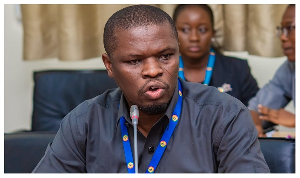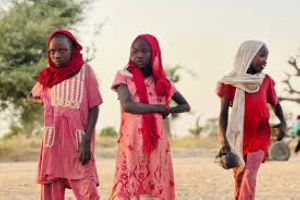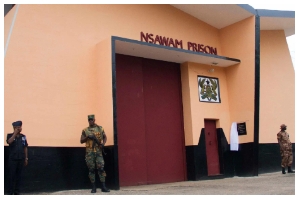GhanaWeb Feature by Etsey Atisu
The people of old say to be authenticated as an Akyem, you must drink water from the Birim River.
At least, that mode of authentication of the tribal acumen of a person existed only firmly in the past, but no longer.
A sad, unfortunate reality, but the Birim River, like the Pra River and other unfortunate water bodies in the country, have been completely defaced and polluted by the continuous, uncontrolled activities of illegal mining, or what everybody knows as ‘galamsey’ in Ghana.
And as one writer casually wrote in an article, the “expression ‘Akyemkwaa a onom Biremu’ changed to ‘Akyemkwaa a onom pure water’ because the Birim River was not good for drinking and even farmer bought sachet water to the farms.
About the Birim River:
The Birim River is one of the main tributaries of the Pra River in Ghana and the country's most important diamond-producing area, flowing through most of the width of the Eastern region.
The river rises in the east of the Atewa Range, flows north through the gap between this range and the Kwahu Plateau, then runs roughly south-west until it joins the Pra. It gives its name to the Birimian rock formation, which yields most of the gold in the region. Ghana is the second largest producer of gold in Africa.
The Birim River basin lies in the Man Shield area of the West African craton, which has been overlaid by Early Proterozoic metasedimentary Birimian rocks. These rocks appear to have originated in mid-oceanic arcs of volcanoes, which formed a crust that collided with and rode over the Man shield portion of the West African Craton and was compressed to form a series of folds generally trending northeasterly. The Birimian rocks include Akwatian formations, named after the town of Akwatia in the Birim valley, which have yielded more than 100,000,000 carats (20,000 kg) of diamonds. The great majority of the diamonds are found in Harzburgitic rocks and seem to have crystallized at unusually high temperatures and pressures deep in the lithosphere.
What happened to the Birim River?
After many years of rigorous, illegal mining activities for gold in the Birim River, it is today a pale shadow of its former days, destroyed by galamsey. The following details is culled from a Wikipedia page.
The Birim River has been degraded as a result of illegal mining activities. The community members and some organizations have requested the government to take action against the illegal miners and protect the river. A group has been formed which consist of 62 people to assist in protecting the river.
The Birim River is also rich in several mineral wealth. The Birim basin has been a source of gold for centuries, the basis for the former name of Ghana: the Gold Coast. It is also a major source of diamonds.
The Birim River gravels hold gold which has long been extracted through panning or Placer mining, used in making ornaments and for trans-Saharan trade long before the Europeans discovered the Gold Coast. Starting in the late 19th century, British gold mining companies adopted conventional mining and extraction processes, developing deep underground mines in the underlying Ashanti belt.
After independence in 1957 the government nationalized the gold mining industry. With inadequate investment, the mines deteriorated and profitability fell. However, after privatization in 1992 the new owners injected capital, mostly into the Ashanti belt mines, discovering new world-class deposits. The Ashanti Belt now has an aggregated gold endowment of over 125,000,000 ounces of gold.
Diamonds: Ghana has produced gems from alluvial gravels since the 1920s, mostly industrial grade. In the early 1990s the government announced plans to privatize its diamond-mining operations but found no buyers.
The government still owns Ghana Consolidated Diamonds, since 2005 the only formal commercial producer of diamonds. Ghana Consolidated Diamonds uses a strip and mine method at their placer mine in Akwatia, using Manitowoc draglines.
The plant is old and obsolescent, available only 38% of the time and producing under capacity. The government is looking for a strategic investor to take over the mine.
In 1989 the government of Ghana set up the Precious Minerals Marketing Corporation (PMMC) to promote small-scale gold and diamond mining and to purchase and resell the output. As much as 70% of the diamonds were smuggled out of the country before the PMMC was created.
In its first sixteen months of operation, the PMMC bought 382,423 carats (76.4846 kg) of diamonds and 20,365 ounces of gold and sold 230,000 carats (46 kg) of diamonds worth US$8 million. However, because of complaints over raw gem sales, the government in March 1992 ordered an investigation into the operations of the state agency and suspended its managing director.
In the 1950s and 1960s the Akwatia area of the Birim valley produced more than 2,000,000 carats (400 kg) annually. However, both volumes and quality are declining. Ghana produced a total of about 800,000 carats (160 kg) of diamonds in 1995, about half of it from Akwatia. The available reserves cover an area of 240 km2 along the Birim River and are estimated to contain 14,000,000 carats (2,800 kg) of proven reserve.
Although the Akwatia deposits are nearly depleted, large additional resources have been identified in the nearby Birim River deposits, including an altered meta-lamproite that may represent a primary diamond source.
Most of the diamond production in the Birim basin is now by artisanal miners from alluvial and in situ diamond deposits near Akwatia. There is some evidence that production volumes from these small-scale operations are increasing.
Bauxite: The Atewa Range at the headwaters of the river contains extensive bauxite deposits with minor kaolin occurrences, which are being evaluated by groups such as BHP. However, the bauxite deposits are generally poor quality compared to larger deposits of higher-quality bauxite in nearby Guinea and are in an environmentally sensitive area, so are unlikely to be developed.
About the Akyem people:
The Akyem people, belonging to the Akan ethnic group, hold a significant place in Ghanaian society and have a fascinating history rooted in bravery and independence. The term “Akyem” refers to a group of four states: Asante Akyem, Akyem Abuakwa, Akyem Kotoku, and Akyem Bosome, located primarily in the eastern region of south Ghana. The Akyem ethnic group, which constitutes approximately 3-4% of Ghana’s population, plays a prominent role in various aspects of Ghanaian life.
The Akyem people have a matrilineal system, where lineage and inheritance are traced through the mother’s line. This unique social structure shapes their cultural practices and societal dynamics. The history of the Akyem people is marked by their resilience and ability to establish a thriving and influential state within modern-day Ghana. When discussing Ghanaian history, the “Big Six” often come to light. These six individuals played a pivotal role in Ghana’s struggle for independence, with individuals of Akyem descent making up the majority of this esteemed group.
The genesis of the Akyem states can be traced to Akyemmansa, which encompasses the three traditional areas of Akyem in the eastern region of Ghana. According to oral history, the Akyem people were part of the Akan migration from the Sahel region to what later became Bono state. The Akan people, including the Akyem, originated from this area, and a group of Akan individuals who left Bonoman eventually formed the Adansi Kingdom in the mid-14th century. The Adansi people were known for their architectural prowess, leading to their designation as “builders.”
During the first half of the 17th century, the region that is now Ghana was dominated by three major states: the Guans, Denkyera, and the Akwamu, with the Adansi state comprising three military posts: Akyem Abuakwa, Akyem Kotoku, and Akyem Bosome. However, the eastern Adansi area lost much of its identity due to conflicts with neighboring states, particularly the Denkyira. Consequently, the Denkyira empire absorbed a significant portion of the Adansi state. By the second half of the 17th century, the region that encompasses present-day Ghana was dominated by several states, including remnants of Adansi, Denkyira, Guans, Dagons, Anlos, Ga, Fante, Akyem, and Akwamu.
The rise of the Ashanti Kingdom under the leadership of Otumfuo Nana Osei Tutu played a crucial role in shaping the destiny of the Akyem people. As the Ashanti Empire expanded its influence through military might, the Akyem people, fearing Ashanti domination, migrated across the River Pra and established new settlements.
In pursuit of the Akyem Kotoku people, the last group of Akyem left on the other side of the river, Otumfuo Nana Osei Tutu met his demise from a Kotoku sniper’s bullet. This event prompted the Ashanti Army to halt their pursuit, returning to the capital, Kumasi, for the King’s funeral and the installation of a new monarch. This Thursday became significant in Ashanti history, commemorated through the oath “Meka Yawada” (I swear by Thursday), as Otumfuo Opoku Ware vowed to avenge the death of his uncle, the late King Osei Tutu.
During the colonial era, conflicts between the Akyem and Ashanti kingdoms continued, often involving alliances with other tribes and kingdoms. The Akyem people played a role in the transatlantic slave trade, selling a substantial number of Ashanti prisoners of war to European slavers on the coast.
One of the significant events in Akyem history is the Akyem conquest of Akwamu in 1730. This victory over the Akwamu, resulting from a controversy involving the Akyem royal family, is regarded as one of the most decisive in the history of the Gold Coast. The Akwamu, having previously destroyed the old Ga kingdom, were now forced by the Akyem to flee their homeland and establish a new capital across the Volta River, where the present-day Akwamu capital lies.
The Akyem people have left an indelible mark on Ghanaian history, demonstrating their bravery, military prowess, and determination to maintain their independence. Their contributions to Ghana’s struggle for independence and their prominence in various spheres of Ghanaian life have solidified their position as a respected and influential ethnic group within the country.
Osagyefuo Amoatia Ofori Panin is the 35th Chief of Akyem Abuakwa, also called Okyeman in the Eastern Region of Ghana. He took his seat on October 4, 1999, succeeding his brother, Osagyefo Kuntukunuku.
President Nana Addo Dankwa Akufo-Addo is also a proud son of Akyem.
With additional files from sophiaapenkro.com
General News of Sunday, 15 September 2024
Source: www.ghanaweb.com

















